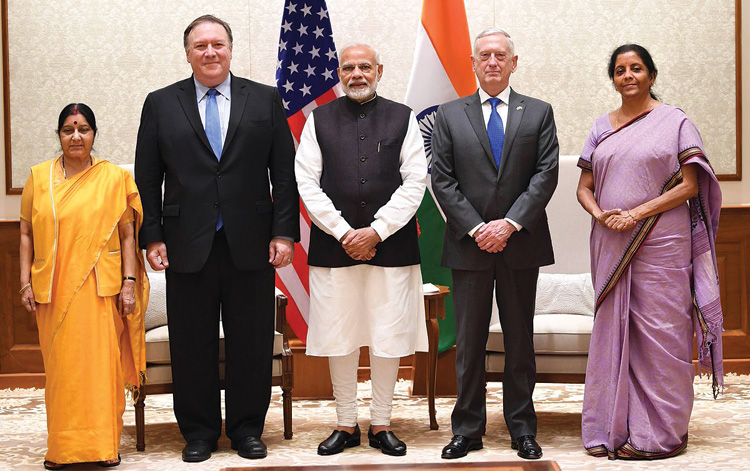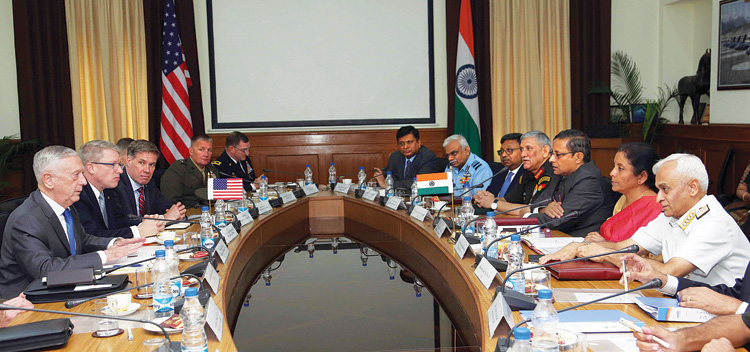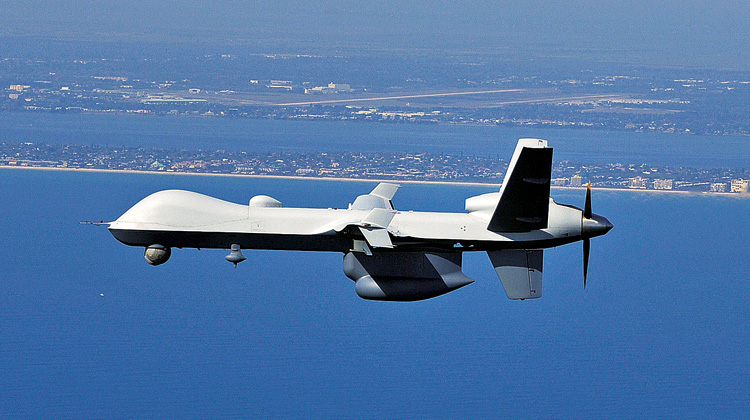INDIAN ARMED FORCES CHIEFS ON OUR RELENTLESS AND FOCUSED PUBLISHING EFFORTS

The insightful articles, inspiring narrations and analytical perspectives presented by the Editorial Team, establish an alluring connect with the reader. My compliments and best wishes to SP Guide Publications.

"Over the past 60 years, the growth of SP Guide Publications has mirrored the rising stature of Indian Navy. Its well-researched and informative magazines on Defence and Aerospace sector have served to shape an educated opinion of our military personnel, policy makers and the public alike. I wish SP's Publication team continued success, fair winds and following seas in all future endeavour!"

Since, its inception in 1964, SP Guide Publications has consistently demonstrated commitment to high-quality journalism in the aerospace and defence sectors, earning a well-deserved reputation as Asia's largest media house in this domain. I wish SP Guide Publications continued success in its pursuit of excellence.
- The layered Air Defence systems that worked superbly, the key element of Operation Sindoor
- Operation Sindoor | Day 2 DGMOs Briefing
- Operation Sindoor: Resolute yet Restrained
- India's Operation Sindoor Sends a Clear Message to Terror and the World – ‘ZERO TOLERANCE’
- Japan and India set forth a defence cooperation consultancy framework, talks on tank and jet engines
COMCASA Enabling Interoperability
Being a ‘Major Defence Partner’ of the US, it is imperative for India to sign the mandatory three foundational pacts which allow greater interoperability between critical technologies and smooth facilitation of classified information.

The landmark Communications Compatibility And Security Agreement (COMCASA) signed between India and the US, is likely to open the way for sales of more sensitive US military equipment to India. The agreement was reached after US Secretary of State Mike Pompeo and US Defence Secretary Jim Mattis met Defence Minister Nirmala Sitharaman and Foreign Minister Sushma Swaraj in New Delhi for the dialogue. COMCASA comes as a major boost for India that in 2016 has been designated by the US as a ‘Major Defence Partner’. Being a ‘Major Defence Partner’ of the US, it is imperative for India to sign the mandatory three foundational pacts which allow greater interoperability between critical technologies and smooth facilitation of classified information. It was under former Defence Minister Manohar Parrikar that Logistics Exchange Memorandum of Agreement (LEMOA) was signed. And now it is Defence Minister Nirmala Sitharaman who got COMCASA off the ground.The foundational agreements are meant to lay the basic ground work and promote interoperability between militaries by creating common standards and systems. They also guide sale and transfer of high-end technologies.
FOUNDATIONAL AGREEMENTS
The three agreements in the original US terminology, are Logistics Security Agreement (LSA), which enables use of each other’s military infrastructure and facilities, Basic Exchange & Cooperation Agreement (BECA) that provides for sharing geo-spatial intelligence and the Communication & Information on Security Memorandum of Agreement (CISMOA), which facilitates the US providing equipment and software for communications security. All these have been part of the discussion ever since the US-India Defence Framework Agreement came into being in 2005 as part of the burgeoning US-India strategic alliance. This was meant to provide operational boost to defence cooperation between the two countries, especially sale of advanced US military hardware to India, which was off the table till then. The US has continually pressed India to sign these agreements, arguing that it would be necessary not only for sale of sensitive defence equipment, but especially for transfer of advanced US military technology, which India was interested in.
Over the last decade, India has made the US its biggest arms supplier, spending around $15 billion on American weaponry
Over the last decade, India has made the US its biggest arms supplier, spending around $15 billion on American weaponry. Yet many US platforms bought have turned out to be less than cutting-edge. After New Delhi’s unwillingness to sign what Washington labels a “foundational agreement”, the Communications Interoperability and Security Memorandum of Agreement (CISMOA), has forced the replacement of closely-guarded radio, communications security and navigation kits with lower-grade, commercially-available equipment. COMCASA creates the conditions for the Indian military to receive modern secure and net-enabled weapons systems such as precision armament, air-to-air missiles, space systems and navigation systems that are critical components in platforms such as fighter aircraft and unmanned aerial systems. Hitherto, India has had to purchase more expensive commercial communications equipment, raising the overall acquisition price of a platform,” said Ben Schwartz, Senior Director (Defence and Aerospace), US-India Business Council (USIBC).

ENHANCING PLATFORMS CAPABILITY THROUGH COMCASA
One example is the C-130J Super Hercules Special Forces aircraft for tactical operations. Such operations need secure communications between the aircraft and tactical teams for surprise and successful operations particularly in an interoperability environment. America tightly controls the communication equipment used for this, denying it to countries that have not signed CISMOA. So far, India had opted for commercially available radio kits, rather than signing CISMOA. Similarly, the Indian Navy’s Boeing P-8I maritime aircraft is amongst the world’s most effective submarine hunters. But detecting and pinpointing an enemy submarine is only the first step, attacking it requires the P-8I to communicate with naval forces in the vicinity and with shorebased naval facilities. Since these voice and data channels called Data Link-11 and Link-16 are guarded under CISMOA, the P-8I has been equipped with older communication equipment. The absence of these links also prevents the P-8I from generating a Common Tactical Picture with friendly regional navies, who operate over CISMOA-protected links.
The Pentagon had repeatedly offered to address Indian concerns, asking New Delhi to identify objectionable clauses in the standard CISMOA draft
There are other such cases. In a conflict with China, the absence of Link-16 would prevent combat aircraft of the Indian Air Force (IAF) from generating a Common Air Picture, even if friendly air forces were eager to communicate with the IAF on the activities of the People’s Liberation Army Air Force (PLAAF). Not signing of CISMOA also denied the military Global Positioning System (GPS) systems and state-of-theart guidance for the Advanced Medium Range Air-to-Air Missile (AMRAAM) that may equip IAF fighters. India’s fleet of 15 CH-47F Chinook helicopters by same logic, will not have navigation and radio equipment of the same sophistication as the helicopters in the US Army.
THE NEGOTIATIONS
While in Delhi in April 2017, US Defence Secretary Ashton Carter argued that American weapon systems were capable even without CISMOA-controlled equipment. But he conceded that India was missing out, saying, “I want to emphasise that there is a lot we can do without the foundational agreements; but there is much more we can do with them.” Carter was part-vindicated on August 29. 2017 when Washington and New Delhi signed the LEMOA, the first of the three foundational agreements. Yet that still left two: CISMOA and the Basic Exchange and Cooperation Agreement for Geospatial Information and Services Cooperation (BECA), which lays down protocols for digital mapping and survey.

CISMOA negotiations have sputtered on sporadically since 2005. On New Delhi’s request, Washington has agreed to rename the agreement COMCASA to allow India a countryspecific agreement, different from what the US Department of Defence has signed with dozens of other countries. A similar logic was employed in the LEMOA, which was given an Indiaspecific name to differentiate it from the LSA that US has signed with other countries.
Even so, merely renaming the agreement would not have made it acceptable to Indian public opinion, since the standard CISMOA draft, the basis of COMCASA negotiations, is inherently more intrusive than LEMOA. A senior Pentagon official who participated in CISMOA negotiations with India confessed, “When we sat down with the Ministry of Defence (MoD) in Delhi and the CISMOA experts explained the draft, even we were taken aback by the intrusiveness. We looked at each other and rolled our eyes, ‘this is not going to happen’.”
Indian Concerns Addressed in COMCASA
The Pentagon had repeatedly offered to address Indian concerns, asking New Delhi to identify objectionable clauses in the standard CISMOA draft. A safeguard agreement for the protective technologies installed on the Prime Minister’s Boeing Business Jet, which are similar to the ones that protect the US President’s aircraft, Air Force One, had been signed earlier by the Government of India. Ben Schwartz of the USIBC downplays concerns terming it “trivial and about as much of a threat to national sovereignty as granting a multinational telecommunications company licence to operate in India.” He argues that both types of activities take place entirely under the laws of the Indian Government.
India has and will continue at least into the medium term, to have military and strategic equipment from diverse sources
LSA, CISMOA and BECA are not particularly exciting agreements. Certainly, none of these represent anything revolutionary. Instead, they are the foundational building blocks for a deeper US-India defence partnership. The LEMOA for India sets a framework for the two countries to share military logistics. Under the reciprocal agreement, both New Delhi and Washington would have the ability, but not the obligation, to assist each other’s armed forces with simple military logistics. For the US Navy for example, logistics support from India would be a valuable asset, helping it better project power in the Indian Ocean. COMCASA for India meanwhile, would allow the US to supply India with its proprietary encrypted communications equipment and systems, allowing secure peacetime and wartime communication between high-level military leaders on both sides. COMCASA would extend this capability to Indian and US military assets, including aircraft and ships. Finally, BECA, when it is negotiated and signed, would set a framework through which the US could share sensitive data with India to aid targeting and navigation. From the perspective of the US, apart from the modest technical benefits of closer cooperation with New Delhi, these agreements are largely about building a foundation of trust. In this way, they are similar to the 2002 General Security of Military Information Agreement (GSOMIA), which, according to then US Defence Secretary Donald Rumsfeld “Paved the way for greater technology cooperation” between the two sides. GSOMIA, which ultimately enabled the Obama administration-era DTTI, LEMOA, COMCASA and BECA, would open new doors for the US and India signalling the start of a new era, coinciding with the recently updated US-India defence framework.
NEW INDUCTIONS FROM THE US
An additional element of urgency is the favourable decision by the US to sell India armed Sea Guardian or more accurately, Predator-B or MQ9-B Reaper drones, superseding the earlier US decision to confine the sale only to the unarmed version. The US had also been leveraging pressure tactics regarding the possible acquisition by India of Russian S-400 missile defence systems, arguing that potential breaches in communications security related to integration of the anti-missile system with other hardware might be serious impediments to the sale of sensitive equipment such as armed drones to India by the US.

Then there is the important issue of communications security for which COMCASA is being made a necessity. NATO and other military allies of the US do not need or want to pursue this goal because they have chosen to be part of a US military alliance, prepared for joint military operations, obviously against declared ‘enemies’ and hence would be quite comfortable working with encrypted US hardware and software.
CONCLUSION
India prides itself in being a leading Information and Communication Technology (ICT) power. India has and will continue at least into the medium term, to have military and strategic equipment from diverse sources. Can India not work out encryption, security and systems integration of diverse hardware and software, among ground, air, space and ocean assets? This is an extremely important issue and well worth dedicated indigenous effort. Achieving this capability will be independent of signing COMCASA as a prerequisite for buying US equipment and thus may help in India’s self-reliance in non-COMCASA equipment.





